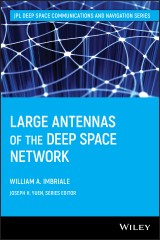Details

Large Antennas of the Deep Space Network
JPL Deep-Space Communications and Navigation Series, Band 1 1. Aufl.
|
217,99 € |
|
| Verlag: | Wiley |
| Format: | |
| Veröffentl.: | 04.02.2005 |
| ISBN/EAN: | 9780471726197 |
| Sprache: | englisch |
| Anzahl Seiten: | 320 |
DRM-geschütztes eBook, Sie benötigen z.B. Adobe Digital Editions und eine Adobe ID zum Lesen.
Beschreibungen
An important historical look at the space program's evolving telecommunications systems<br /> <br /> Large Antennas of the Deep Space Network traces the development of the antennas of NASA's Deep Space Network (DSN) from the network's inception in 1958 to the present. It details the evolution of the large parabolic dish antennas, from the initial 26-m operation at L-band (960 MHz) through the current Ka-band (32 GHz) systems. Primarily used for telecommunications, these antennas also support radar and radio astronomy observations in the exploration of the solar system and the universe. In addition, the author also offers thorough treatment of the analytical and measurement techniques used in design and performance assessment.<br /> <br /> Large Antennas of the Deep Space Network represents a vital addition to the literature in that it includes NASA-funded research that significantly impacts on deep space telecommunications. Part of the prestigious JPL Deep Space Communications and Navigation Series, it captures fundamental principles and practices developed during decades of deep space exploration, providing information that will enable antenna professionals to replicate radio frequencies and optics designs.<br /> <br /> Designed as an introduction for students in the field as well as a reference for advanced practitioners, the text assumes a basic familiarity with engineering and mathematical concepts and technical terms.<br /> <br /> The Deep Space Communications and Navigation Series is authored by scientists and engineers with extensive experience in astronautics, communications, and related fields. It lays the foundation for innovation in the areas of deep space navigation and communications by disseminating state-of-the-art knowledge in key technologies.
<p>Foreword xi</p> <p>Preface xiii</p> <p>Acknowledgments xv</p> <p>Chapter 1: Introduction 1</p> <p>Chapter 2: Deep Space Station 11: Pioneer-The First Large Deep Space Network Cassegrain Antenna 71</p> <p>Chapter 3: Deep Space Station 12: Echo 79</p> <p>Chapter 4: Deep Space Station 13: Venus 89</p> <p>Chapter 5: Deep Space Station 14: Mars 97</p> <p>Chapter 6: Deep Space Station 15: Uranus-The First 34-Meter High-Efficiency Antenna 157</p> <p>Chapter 7: The 34-Meter Research and Development Beam-Waveguide Antenna 167</p> <p>Chapter 8: The 34-Meter Beam-Waveguide Operational Antennas 225</p> <p>Chapter 9: The Antenna Research System Task 257</p> <p>Chapter 10: The Next-Generation Deep Space Network 283</p> <p>Acronyms and Abbreviations 295</p>
"There is great benefit from the analysis and physical insight presented in this book." (<i>IEEE Antennas and Propagation</i>, February 2004)
<p><b>WILLIAM A. IMBRIALE</b> is Senior Research Engineer at the California Institute of Technology's Jet Propulsion Laboratory.
<p><b>AN IMPORTANT HISTORICAL LOOK AT THE SPACE PROGRAM'S EVOLVING TELECOMMUNICATIONS SYSTEMS</b> <p><i>Large Antennas of the Deep Space Network</i> traces the development of the antennas of NASA's Deep Space Network (DSN) from the network's inception in 1958 to the present. It details the evolution of the large parabolic dish antennas, from the initial 26-m operation at L-band (960 MHz) through the current Ka-band (32 GHz) systems. Primarily used for telecommunications, these antennas also support radar and radio astronomy observations in the exploration of the solar system and the universe. In addition, the author also offers thorough treatment of the analytical and measurement techniques used in design and performance assessment. <p><i>Large Antennas of the Deep Space Network</i> represents a vital addition to the literature in that it includes NASA-funded research that significantly impacts on deep space telecommunications. Part of the prestigious JPL Deep Space Communications and Navigation Series, it captures fundamental principles and practices developed during decades of deep space exploration, providing information that will enable antenna professionals to replicate radio frequencies and optics designs. <p>Designed as an introduction for students in the field as well as a reference for advanced practitioners, the text assumes a basic familiarity with engineering and mathematical concepts and technical terms. <p><i>The Deep Space Communications and Navigation Series</i> is authored by scientists and engineers with extensive experience in astronautics, communications, and related fields. It lays the foundation for innovation in the areas of deep space navigation and communications by disseminating state-of-the-art knowledge in key technologies.
Diese Produkte könnten Sie auch interessieren:

Classification, Parameter Estimation and State Estimation

von: Bangjun Lei, Guangzhu Xu, Ming Feng, Yaobin Zou, Ferdinand van der Heijden, Dick de Ridder, David M. J. Tax

101,99 €
















